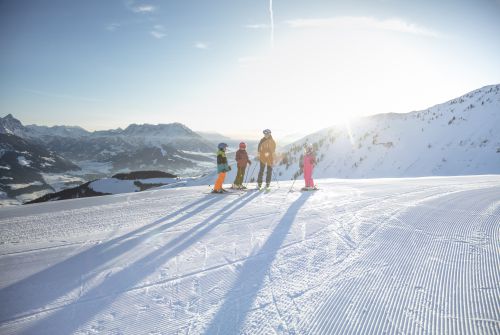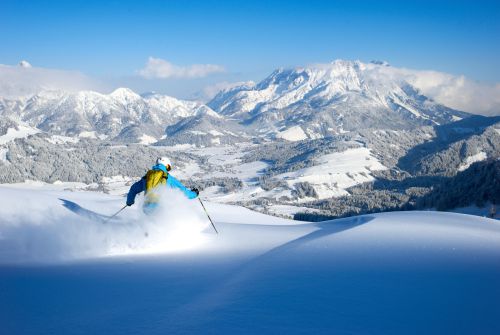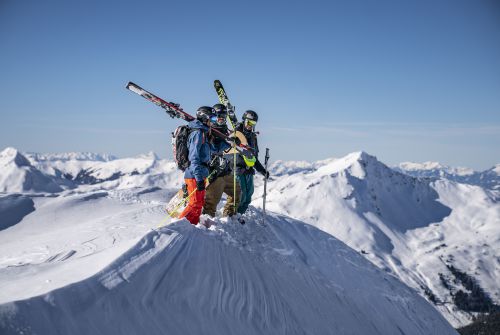Safety on the piste
Simple rules of conduct for better interaction on the pistes!
Skiing is still one of the most popular sports in the Alpine region. Especially during holiday periods, huge crowds populate the mountains and pistes of the Kitzbühel Alps. Simple safety tips and rules of conduct help guaranteeing fun and safety on the pistes even when they are being used by many skiers.
The 10 FIS rules of conduct
Respect for other skiers and snowboarders: A skier or snowboarder must behave in such a way that he does not endanger or prejudice others.
Control of speed and skiing or snowboarding: A skier or snowboarder must move in control. He must adapt his speed and manner of skiing or snowboarding to his personal ability and to the prevailing conditions of terrain, snow and weather as well as to the density of traffic.
Choice of route: A skier or snowboarder coming from behind must choose his route in such a way that he does not endanger skiers or snowboarders ahead.
Overtaking: A skier or snowboarder may overtake another skier or snowboarder above or below and to the right or to the left provided that he leaves enough space for the overtaken skier or snowboarder to make any voluntary or involuntary movement.
Entering, starting and moving upwards: A skier or snowboarder entering a marked run, starting again after stopping or moving upwards on the slopes must look up and down the slopes that he can do so without endangering himself or others.
Stopping on the slope: Unless absolutely necessary, a skier or snowboarder must avoid stopping on the slope in narrow places or where visibility is restricted. After a fall in such a place, a skier or snowboarder must move and clear of the slope as soon as possible.
Climbing and descending on foot: A skier or snowboarder either climbing or descending on foot must keep to the side of the slope.
Respect for signs and markings: A skier or snowboarder must respect all signs and markings.
Assistance: In case of accidents, every skier or snowboarder is duty bound to assist.
Identification: Every skier or snowboarder and witness, whether a responsible party or not, must exchange names and addresses following an accident.
Spotting alpine hazards in time
Even the best equipment is of little use if the user overestimates his/her skills or does not take the forces of nature seriously. In order to provide those unfamiliar with the area with some orientation, the pistes are rated according to difficulty levels and equipped with information signs indicating any possible dangers.
The edge of the piste is the border of the piste area, within which the piste manager fulfils his/her security obligation. The edge of the piste can be determined by natural conditions, or made visible artificially. An easy piste also suited for beginners is marked in blue. Here, the incline must not exceed 25 percent longitudinal and lateral gradient. Red indicates medium-difficult pistes for more experienced skiers, black pistes are a challenge for experts.

Avalanches and no-entry signs
The cable cars and piste operators take all measures to ensure skiing in the Kitzbühel Alps is as safe as possible. In particular after snowfall, it can thus occur that individual pistes or sections must be temporarily closed, in order to carry out avalanche blasting or to restore safety on the piste.
Regardless, the users of the infrastructures must take into account natural hazards on AND next to the ski pistes at all times. Avalanche warnings and no-entry signs should absolutely be taken seriously by everyone. Instructions by the lift personnel or piste service must always be followed.
Making emergency calls
Fast and reliable emergency and accident reports are of particular importance and life-saving in emergencies. In the mountains, the Euro-emergency call is one of the most important numbers, because due to geographical circumstances, full mobile communications coverage is barely possible. It may occur that a mobile phone user does not have any reception with his/her mobile phone in an Alpine emergency. In this situation, he/she can switch off the mobile phone and after restarting it, dial the number “112” or directly press the emergency call button (if available) instead of entering the PIN code. By doing this, the mobile phone will automatically select the strongest radio network.
Further benefits of the Euro-emergency call 112, which distinguish it from all other numbers: It can be used for free in all European countries and even without a SIM card. Furthermore, it is considered an “SOS”-call and is thus given priority in the radio network. The Euro-emergency call always has priority, other phone calls may even be interrupted as a result.
Important call numbers
| Coordination centre | Call number |
| General rescue coordination centre | 144 |
| Mountain rescue | 140 |
| Police | 133 |
| Fire service | 122 |
| Euro-emergency call | 112 |



